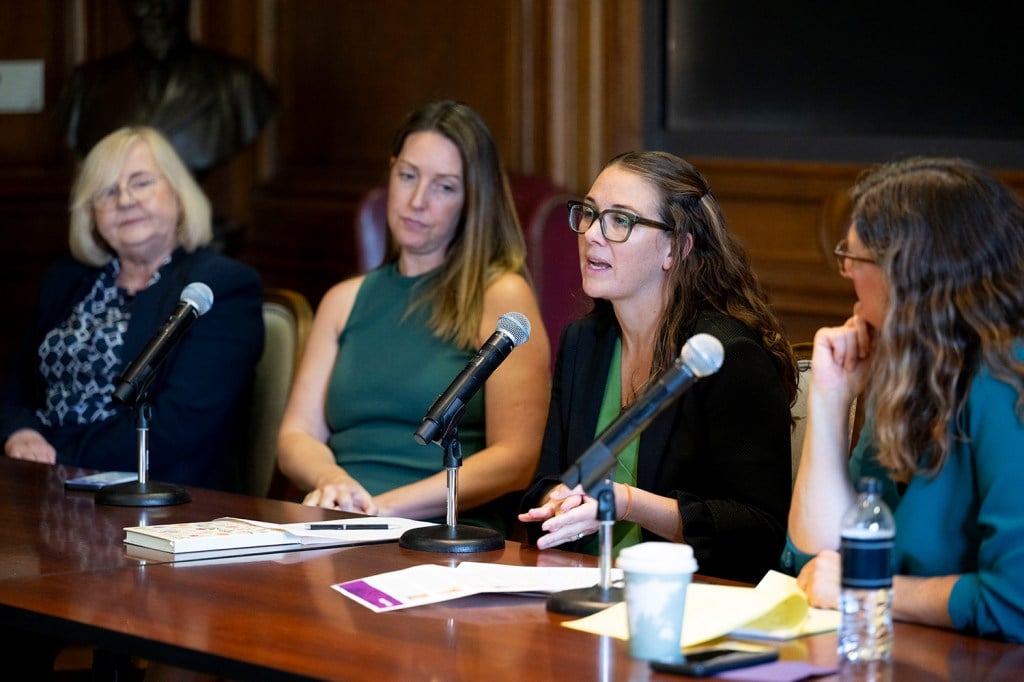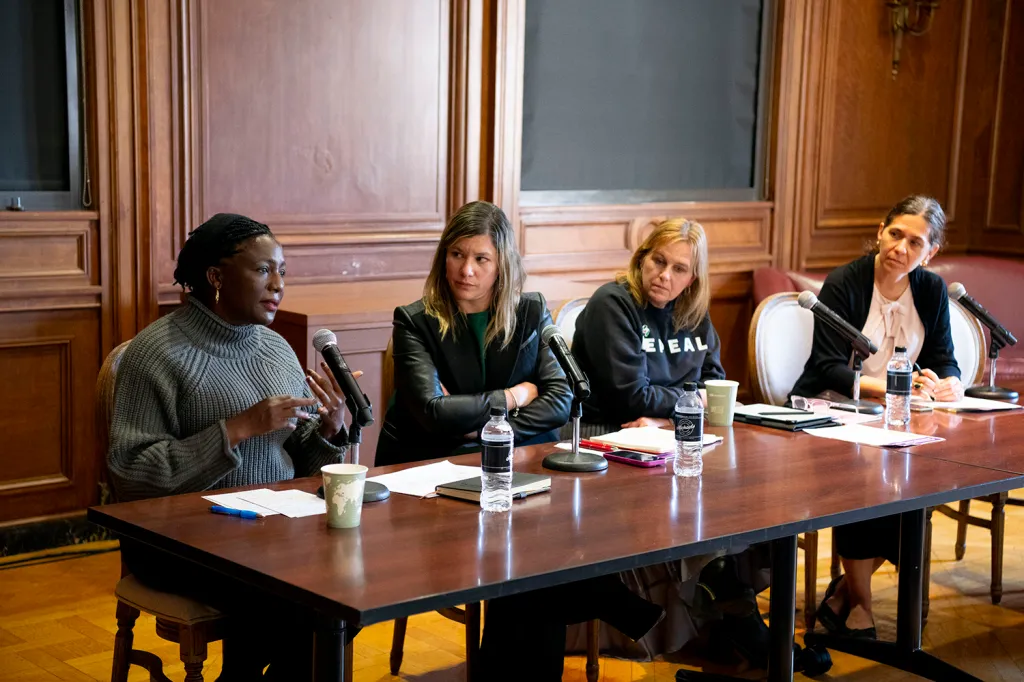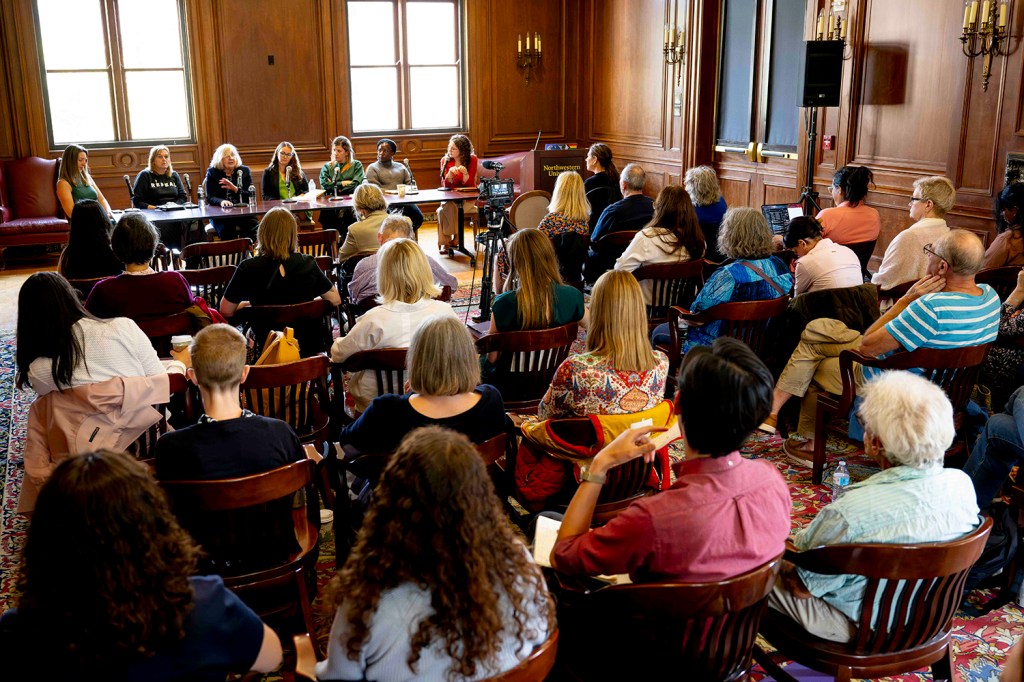Building Transnational Momentum to Ensure Abortion Access
Cross-National Learnings and Pathways Forward
An FP Analytics synthesis report on key takeaways from Abortion Access Today: Global Insights and Comparisons, a symposium hosted by the Roberta Buffett Institute for Global Affairs at Northwestern University in October 2024.
The global abortion landscape is marked by contrasts. In the three decades since the Beijing Declaration urged governments to recognize and tackle the impacts of unsafe abortions, 60 countries have liberalized their abortion laws. One recent example is France, which in March 2024 enshrined abortion rights in its constitution as a guaranteed freedom. Yet, 40 percent of women worldwide live in countries with full or partial abortion restrictions. In recent years, at least four countries—the United States, Poland, Nicaragua, and El Salvador—have reversed course on the right to abortion, impacting not just access but also broader health outcomes and gender equity.
But restrictions on abortion are not just a matter of domestic politics. Abortion access has also proven to be a key international policy issue, producing wide ranging impacts. The U.S. Global Gag Rule, in effect from 1984 to 1992, 2001 to 2008, and 2017 to 2020, broadly restricted funding for abortion access in international aid and led to disruptions in health services worldwide. In 2020, the U.S. Government Accountability Office reported that the 2017 reinstatement of the gag rule led to a USD 150 million decline in funding for family planning and reproductive health, HIV/AIDS, tuberculosis, maternal and child health, and nutrition programs, primarily in Africa. At the same time, transnational social movements to establish and expand abortion-rights, such as the green bandana (pañuelo verde) movement in Latin America, are contributing to the liberalization of abortion laws in countries including Argentina, Colombia, and Mexico.
Recognizing that these divergent trends have implications for civil and political rights as well as the achievement of global sustainable development goals, the Roberta Buffett Institute for Global Affairs at Northwestern University hosted an international symposium, Abortion Access Today: Global Insights and Comparisons on October 11, 2024. The symposium brought together leading strategists, researchers, medical practitioners, and human rights advocates from Colombia, Ireland, Kenya, Poland, and the United States to discuss the factors shaping abortion access globally, drawing on diverse perspectives and sharing lessons from different countries.
The symposium consisted of three sessions, focusing on the current status of, and future access to, abortion.
The discussions addressed three key questions:
- Where is abortion access heading globally, and what factors are influencing trajectories in different regions?
- What can we learn from the strategies making significant impacts in various global contexts?
- When and how has abortion—a very private issue—become a matter of foreign policy?
Global Restrictions in Abortion Access
This panel examined efforts to restrict abortion access in various countries, analyzing the political and social dynamics behind rollbacks in countries like Poland and the United States. Participants shared strategies for resisting policy reversals while highlighting the risks faced by those who ensure access in restrictive environments.

Participants
Krystyna Kacpura, Executive Director of the Foundation for Women and Family Planning (FEDERA) in Poland
Katherine Mayall, JD, Director of Strategic Initiatives within the Legal Strategies, Innovation & Research unit of the Center for Reproductive Rights
Caitlin Bernard, MD, Assistant Professor of Clinical Obstetrics & Gynecology at the Indiana University School of Medicine and one of only two physicians still performing abortions in Indiana
Moderator: Katie Watson, JD, Professor of Obstetrics & Gynecology at the Northwestern University Feinberg School of Medicine
Key Takeaways
- Abortion access continues to be politicized and criminalized, despite being an essential health care issue. In Poland, the restrictive abortion law proved difficult to repeal due to a politicized and protracted legislative process. Reforms are dependent on political events such as the next presidential elections in 2025, rather than on medical advice and public health needs.
- Grassroots organizations, health care providers, and women seeking abortions have devised workarounds to ensure access to abortion care despite legal restrictions. These efforts include travelling to other states or countries where abortion is legal, and providing support to vulnerable groups such as refugees. However, these makeshift solutions are precarious and unsustainable and have caused delays that affect the health and well-being of women and adolescent girls.
- Abortion service providers face harassment, targeting, and legal risks, which impede their work and undermine health care. For example, in the United States, state-level restrictions have led to clinic closures, forcing providers to leave certain states. Supporting and protecting these providers is essential for ensuring continued access to safe abortions.
- Lessons from restrictions on abortion access offer an opportunity to reimagine supportive policies. Restrictions often impose arbitrary gestational limits such as six-week bans or conscience clauses to try to make people reconsider seeking an abortion, which hinder access and delay medical care. Several panelists argued that having no abortion law would be preferable, leaving abortion as a purely medical decision between patients and physicians, free from political interference.
Global Expansions in Abortion Access
This panel discussed recent successes in expanding abortion access, focusing on the strategies and coalitions that led to these positive changes in Ireland and Colombia. Participants shared insights from their campaigns and discussed how these lessons might be applied in other contexts while also emphasizing that challenges to abortion access persist, such as in Kenya.

Participants
Catalina Martinez, JD, Vice President of the Latin America & the Caribbean unit of the Center for Reproductive Rights
Evelyne Opondo, JD, Director of the International Center for Research on Women’s Africa offices
Camilla Fitzsimons, PhD, Associate Professor of Adult and Community Education at Maynooth University in Ireland and author of Repealed: Ireland’s Unfinished Fight for Reproductive Rights
Moderator: Sarah Rodriguez, PhD, Associate Professor of Instruction at the Northwestern University Weinberg College of Arts & Sciences’ Program in Global Health Studies
Key Takeaways
- Persistent advocacy efforts can expand abortion access, even in traditionally conservative contexts. Ireland’s thirty-five-year campaign, led by unrelenting feminist advocates, resulted in the 2018 referendum outcome in favor of abortion access. In Colombia, as the country emerged from a long-running civil war, and civil and political rights were being strengthened, social mobilization, combined with a lawsuit at the Constitutional Court, proved effective in overcoming abortion access restrictions, with a 2022 Constitutional Court ruling protecting abortion access.
- National progress on abortion access can be undermined by the foreign aid policies of donor countries. In 2013, the Kenyan government created guidelines for the provision of safe abortion services. However, they retracted these guidelines almost immediately, following concerns about U.S. foreign assistance. Although the global gag rule was not in effect that year, there were fears that Kenyan health programs would lose funding if their representatives were to attend meetings about these guidelines. As a result, safe abortion remained difficult for Kenyan women to access; according to one report, seven women and girls in Kenya die each day from unsafe abortions. In 2019, the Kenyan High Court ruled that the withdrawal of the guidelines had been illegal and arbitrary.
- Tailoring messages to different audiences can unlock wider support for abortion access. In Colombia, advocates developed distinct narratives targeting various sectors of society. They emphasized personal autonomy in some instances, framed abortion access as a public health and social justice issue in others, and for lawmakers, presented it as a matter for health care regulations rather than the penal code. Their strategy also included engaging 200 cultural influencers, such as musicians, to speak out about abortion rights in ways that resonated with them, amplifying the advocacy. This varied approach helped to broaden support by addressing different concerns and perspectives.
- Building diverse, intersectional coalitions can strengthen abortion rights movements. Successful campaigns involved collaboration across different sectors of society, including reaching out to non-traditional allies such as progressive religious groups, and addressing the intersections of abortion access with race, class, and geography. In Ireland, during the 2018 referendum to expand abortion access, 20,000 volunteers were involved in door-to-door canvassing, demonstrating the importance of broad-based community mobilization to effect change.
Global Trajectories of Abortion Access
This panel explored the international factors that shape abortion access worldwide. Participants discussed the influence of foreign policies, transnational advocacy networks, disinformation campaigns, emerging technologies, and geopolitical shifts on national abortion laws and access.

Participants
Krystyna Kacpura, Executive Director of the Foundation for Women and Family Planning (FEDERA) in Poland
Katherine Mayall, JD, Director of Strategic Initiatives within the Legal Strategies, Innovation & Research unit of the Center for Reproductive Rights
Caitlin Bernard, MD, Assistant Professor of Clinical Obstetrics & Gynecology at the Indiana University School of Medicine and one of only two physicians still performing abortions in Indiana
Catalina Martinez, JD, Vice President of the Latin America & the Caribbean unit of the Center for Reproductive Rights
Evelyne Opondo, JD, Director of the International Center for Research on Women’s Africa offices
Camilla Fitzsimons, PhD, Associate Professor of Adult and Community Education at Maynooth University in Ireland and author of Repealed: Ireland’s Unfinished Fight for Reproductive Rights
Moderator: Deborah Cohen, PhD, Director of the Northwestern Buffett Institute for Global Affairs and Richard W. Leopold Professor of History at the Weinberg College of Arts & Sciences
Key Takeaways
- Transnational anti-abortion groups have become increasingly sophisticated in their tactics to influence government policy. Panelists highlighted tactics such as blackmailing key government leaders and orchestrating the demotion of officials supporting abortion access. They stressed the need to “demystify their narratives,” increase understanding of the groups’ operations, and recognize that their influence extends beyond religious arguments to issues of power and governance.
- Misinformation campaigns continue to spread in the digital realm, creating risks for abortion care advocates and providers while impeding global abortion access. Although governments are often scrutinized for their abortion policies, the role of technology companies in controlling abortion-related information also warrants attention. Stakeholders should hold technology companies accountable for their part in global abortion disinformation campaigns. At the same time, organizations need to actively pursue public education initiatives to combat false narratives and destigmatize abortion discussions.
- Creative strategies to expand abortion access vary by context but share themes of solidarity, information sharing, and targeted messaging. These strategies range from solidarity campaigns, such as Polish women declaring on social media their willingness to be jailed alongside an activist prosecuted for sending abortion pills to a sexual violence survivor, to legal actions such as filing lawsuits in the U.S. on behalf of women affected by abortion restrictions. Campaigns such as sending cushions to a politician in Ireland or wearing green bandannas in Colombia gave high public visibility to the cause.
- Health care providers can help in expanding abortion access, not only through providing services but also as trusted sources of information. Medical professionals need support to effectively frame issues in ways that the public can understand. Moreover, the rise of telemedicine and medicated abortions is reshaping abortion access globally, making it essential to understand how to safely and equitably integrate them into health care systems.
Looking Ahead
Expanding abortion access involves collaborative efforts across sectors and borders. As panelists emphasized, achieving reforms is a long-term process, which requires sustained momentum and adaptable strategies to advance abortion rights worldwide. Situating abortion access within broader global agendas, such as the sustainable development goals, can mobilize additional resources and support. Moreover, legal victories are just the beginning, as ensuring equitable access on the ground remains a challenge, due to barriers such as geographic disparities, economic constraints, and cultural stigma. Policymakers, health care providers, and the civil society need to continuously work to protect and expand abortion access in order to secure full implementation that leaves no one behind.
By Angeli Juani (Senior Policy and Quantitative Analyst). Photos by Nathan Mandell.
Ensuring Global Abortion Access in an Evolving Geopolitical Landscape
Abortion policies are shaped by international and domestic politics, but expanding safe access is critical to global health, gender equality, and sustainable development goals.
Read the full Insight Brief by FP Analytics here, produced with support from the Roberta Buffett Institute for Global Affairs

This synthesis report was produced by FP Analytics, the independent research division of The FP Group, with support from the Roberta Buffett Institute for Global Affairs at Northwestern University. FP Analytics retained control of the direction and findings of this synthesis report. Foreign Policy’s editorial team was not involved in the creation of this content.


